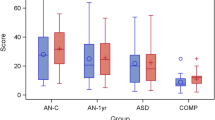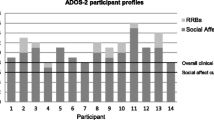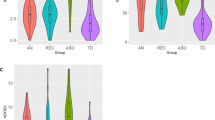Abstract
This study aimed to examine the presence of Autism Spectrum Disorder (ASD) in a sample of female adolescents with Anorexia Nervosa (AN) during the acute phase of illness. We also compare the level of autistic traits, social perception skills and obsessive–compulsive symptoms in four groups: AN, ASD, and two gender- and age-matched control groups. Of the 30 AN participants, only three scored above the conventional ADOS-2 threshold for ASD. The AN participants were similar to their controls on autistic trait measures, and to the ASD group on obsessive–compulsive measures, and on theory of mind ability and affect recognition measures. Further longitudinal studies are needed in order to determine the association between these conditions.

Similar content being viewed by others
References
American Psychiatric Association. (2013). The diagnostic and statistical manual of mental disorders. (5th ed). Washington, DC: American Psychiatric Association.
Anckarsäter, H., Hofvander, B., Billstedt, E., Gillberg, I. C., Gillberg, C., Wentz, E., et al. (2012). The sociocommunicative deficit subgroup in anorexia nervosa: autism spectrum disorders and neurocognition in a community-based, longitudinal study. Psychological Medicine, 42, 1957–1967.
Anderluh, M., Tchanturia, K., Rabe-Hesketh, S., Collier, D., & Treasure, J. (2009). Lifetime course of eating disorders: Design and validity testing of a new strategy to define the eating disorders phenotype. Psychological Medicine, 39, 105–114.
Auyeung, B., Baron-Cohen, S., Wheelwright, S., & Allison, C. (2008). The autism spectrum quotient: Children’s version (AQ-Child). Journal of Autism and Developmental Disorders, 38, 1230–1240.
Baron-Cohen, S., Hoekstra, R. A., Knickmeyer, R., & Wheelwright, S. (2006). The autism spectrum quotient (AQ)-adolescent version. Journal of Autism and Developmental Disorders, 36, 343–350.
Baron-Cohen, S., Jaffa, T., Davies, S., Auyeung, B., Allison, C., & Wheelwright, S. (2013). Do girls with anorexia nervosa have elevated autistic traits? Molecular Autism, 4, 24.
Baron-Cohen, S., Wheelwright, S., Skinner, R., Martin, J., & Clubley, E. (2001). The autism spectrum quotient (AQ): evidence from Asperger syndrome/high-functioning autism, males and females, scientists and mathematicians. Journal of Autism and Developmental Disorders, 31, 5–17.
Birmingham, C. L., & Beumont, P. J. V. (2004). A Practical handbook for healthcare professionals. Medical management of eating disorders. Cambridge: Cambridge University Press.
Calderoni, S., Fantozzi, P., Balboni, G., Pagni, V., Franzoni, E., Apicella, F., et al. (2015). The impact of internalizing symptoms on autistic traits in adolescents with restrictive anorexia nervosa. Neuropsychiatric Disease and Treatment, 11, 75–85.
Calderoni, S., Muratori, F., Leggero, C., Narzisi, A., Apicella, F., Balottin, U., et al. (2013). Neuropsychological functioning in children and adolescents with restrictive-type anorexia nervosa: an in-depth investigation with NEPSY-II. Journal of Clinical and Experimental Neuropsychology, 35(2), 167–179.
Carton, A. M., & Smith, A. D. (2014). Assessing the relationship between eating disorder psychopathology and autistic traits in a non-clinical adult population. Eating and Weight Disorders, 19(3), 285–293.
Chakraborty, K., & Basu, D. (2010). Management of anorexia and bulimia nervosa: an evidence-based review. Indian Journal of Psychiatry, 52(2).
Coombs, E., Brosnan, M., Bryant-Waugh, R., & Skevington, S. M. (2011). An investigation into the relationship between eating disorder psychopathology and autistic symptomatology in a non-clinical sample. British Journal of Clinical Psychology, 50, 326–338.
Courty, A., Maria, A. S., Lalanne, C., Ringuenet, D., Vindreau, C., Chevallier, C., et al. (2013). Levels of autistic traits in anorexia nervosa: a comparative psychometric study. BMC Psychiatry, 13, 222.
Cuzzolaro, M., Vetrone, G., Marano, G., & Battacchi, M. (2000). Body uneasiness test (BUT) In L. Conti (Eds.), Repertorio delle scale di valutazione in psichiatria. Firenze: SEE.
Cuzzolaro, M., Vetrone, G., Marano, G., & Garfinkel, P. E. (2006). The body uneasiness test (BUT): Development and validation of a new body image assessment scale. Eating and Weight Disorders, 11, 1–13.
De Bildt, A., Systema, S., Kraijer, D., & Minderaa, R. (2004). Prevalence of pervasive developmental disorders in children and adolescents with mental retardation. Journal of Child Psychology and Psychiatry, 46, 275–286.
Developmental Disabilities Monitoring Network Surveillance Year (2010). Principal Investigators; Centers for Disease Control and Prevention (CDC). (2014). Prevalence of autism spectrum disorder among children aged 8 years - autism and developmental disabilities monitoring network, 11 sites, United States, 2010. Morbidity and Mortality Weekly Report. Surveillance Summaries, 63(2), 1–21.
Garner, D. M. (2004). Eating disorder inventory-3. Professional Manual. Lutz, FL: Psychological Assessment Resources, Inc.
Garner, D. M., Olmsted, M. P., Bohr, Y., & Garfinkel, P. (1982). The eating attitude test: psychometric features and clinical correlates. Psychological Medicine, 12(4), 871–878.
Giannini, M., Pannocchia, L., Dalle Grave, R., Muratori, F., & Viglione, V. (2008). Eating Disorder Inventory-3. Firenze: Giunti OS.
Gillberg, C., Råstam, M., & Gillberg, C. (1995). Anorexia nervosa 6 years after onset: Part I. Personality disorders. Comprehensive Psychiatry, 36, 61–69.
Hambrook, D., Tchanturia, K., Schmidt, U., Russell, T., & Treasure, J. (2008). Empathy, systemizing, and autistic traits in anorexia nervosa: A pilot study. British Journal of Clinical Psychology, 47, 335–339.
Head, A. M., McGillivray, J. A., & Stokes, M. A. (2014). Gender differences in emotionality and sociability in children with autism spectrum disorders. Molecular Autism, 5(1), 19.
Holtmann, M., Bolte, S., & Poustka, F. (2007). Autism spectrum disorders: Sex differences in autistic behavior domains and coexisting psychopathology. Developmental Medicine & Child Neurology, 49(5), 361–366.
Huke, V., Turk, J., Saeidi, S., Kent, A., & Morgan, J. F. (2013). Autism spectrum disorders in eating disorder populations: a systematic review. European Journal of Eating Disorders Review, 21(5), 345–351.
Huke, V., Turk, J., Saeidi, S., Kent, A., & Morgan, J. F. (2013). The clinical implications of high levels of autism Spectrum disorder features in anorexia nervosa: A pilot study. European Journal of Eating Disorders Review, 22(2), 116–121.
Hus, V., & Lord, C. (2014). The autism diagnostic observation schedule, Module 4: Revised algorithm and standardized severity scores. Journal of Autism and Developmental Disorders, 44(8), 1996–2012.
Korkman, M., Kirk, U., & Kemp, S. (2011). NEPSY– II. Italian adaptation. (2nd ed). Firenze: Giunti O.S. Organizzazioni Speciali.
Korkman, M., Kirk, U., & Kemp, S. L. (2007). NEPSY-II. Clinical and interpretative manual. San Antonio TX: Psychological Corporation.
Lang, K., Dapelo, M. M., Khondoker, M., Morris, R., Surguladze, S., Treasure, J., & Tchanturia, K. (2015). Exploring emotion recognition in adults and adolescents with anorexia nervosa using a body motion paradigm. European Eating Disorders Review.
Lang, K., Lopez, C., Stahl, D., Tchanturia, K., & Treasure, J. (2014a). Central coherence in eating disorders: An updated systematic review and meta-analysis. The World Journal of Biological Psychiatry, 15(8), 586–598.
Lang, K., Stahl, D., Espie, J., Treasure, J., & Tchanturia, K. (2014b). Set shifting in children and adolescents with anorexia nervosa: An exploratory systematic review and meta-analysis. International Journal of Eating Disorders, 47(4), 394–399.
Lopez, C., Stahl, D., & Tchanturia, K. (2010). Estimated intelligence quotient in anorexia nervosa: A systematic review and meta-analysis of the literature. Annals in General Psychiatry, 9, 40.
Lord, C., Luyster, R., Gotham, K., & Guthrie, W. (2012). Autism diagnostic observation schedule, Second edition (ADOS-2) Manual (Part II): Toddler module. Torrance, CA: Western Psychological Services.
Lord, C., Rutter, M., Di Lavore, P.C., Risi, S., & Gotham, K. (2012). ADOS-2: Autism diagnostic observation schedule. Los Angeles: Western Psychological Service.
Lugnegard, T., Hallerback, M. U., & Gillberg, C. (2015). Asperger syndrome and schizophrenia: Overlap of self-reported autistic traits using the Autism-spectrum Quotient (AQ). Nordic Journal of Psychiatry, 69(4), 268–274.
Mandy, W., Charman, T., Gilmour, J., & Skuse, D. (2011). Towards specifying pervasive developmental disorder unspecified. Autism Research, 4, 121–131.
Mandy, W., & Tchanturia, K. (2015). Do women with eating disorders who have social and flexibility difficulties really have autism? A case series. Molecular Autism, 6, 6.
Mazzone, L., Postorino, V., De Peppo, L., Fatta, L., Lucarelli, V., Reale, L., et al. (2013). Mood symptoms in children and adolescents with autism spectrum disorders. Research in Developmental Disabilities, 34(11), 3699–3708.
Mazzone, L., Ruta, L., & Reale, L. (2012). Psychiatric comorbidities in asperger syndrome and high functioning autism: diagnostic challenges. Annals of General Psychiatry, 11(1), 16.
Mehler, P. S., & Andersen, A. E. (1999). Eating disorders: A guide to medical care and complications. Baltimore: Johns Hopkins University Press.
Miller, J. S., Bilder, D., Farley, M., Coon, H., Pinborough-Zimmerman, J., Jenson, W., et al. (2012). Autism spectrum disorder reclassified: A second look at the 1980s Utah/UCLA autism epidemiologic study. Journal of Autism and Developmental Disorders, 43, 200–210.
Miller, K. K., Grinspoon, S. K., Ciampa, J., Hier, J., Herzog, D., & Klibanski (2005). A. medical findings in outpatients with anorexia nervosa. Archives of Internal Medicine, 165, 561–566.
Mondschein, E. R., Adolph, K. E., & Tamis-LeMonda, C. S. (2000). Gender bias in mothers’ expectations about infant crawling. Journal of Experimental Child Psychology, 77(4), 304–316.
Oldershaw, A., Hambrook, D., Tchanturia, K., Treasure, J., & Schmidt, U. (2010). Emotional theory of mind and emotional awareness in recovered anorexia nervosa patients. Psychosomatic Medicine, 72(1), 73–79.
Pooni, J., Ninteman, A., Bryant-Waugh, R., Nicholls, D., & Mandy, W. (2012). Investigating autism spectrum disorder and autistic traits in early onset eating disorder. International Journal of Eating Disorders 45,4 583–591.
Postorino, V., Fatta L. M., De Peppo L., Giovagnoli G., Armando M., Vicari S., et al. (2015). Longitudinal comparison between male and female preschool children with autism spectrum disorder. Journal of Autism and Developmental Disorders, 45(7), 2046–2055.
Råstam, M. (1992). Anorexia nervosa in 51 Swedish adolescents: Premorbid problems and comorbidity. Journal of the American Academy of Child and Adolescent Psychiatry, 31, 5.
Råstam, M., Gillberg, C., & Wentz, E. (2003). Outcome of teenage onset anorexia nervosa in a Swedish-community based sample. European Child and Adolescent Psychiatry, 12, 78–90.
Raven, J. C. (2008a). Standard Progressive Matrices. Firenze: Giunti Organizzazioni Speciali.
Raven, J. C. (2008b). Colored Progressive Matrices. Firenze: Giunti Organizzazioni Speciali.
Rhind, E., Bonfioli, R., Hibbs, E., Goddard, P., Macdonald, S., Gowers, U., et al. (2014). An examination of autism spectrum traits in adolescents with anorexia nervosa and their parents. Molecular Autism, 5, 56.
Roberts, M. E., Tchanturia, K., Stahl, D., Southgate, L., & Treasure, J. (2007). A systematic review and meta-analysis of set-shifting ability in eating disorders. Psychological Medicine, 37(8), 1075–1084.
Russell, G., Steer, C., & Golding, J. (2011). Social and demographic factors that influence the diagnosis of autistic spectrum disorders. Social Psychiatry and Psychiatric Epidemiology, 46, 1283–1293.
Russell, T. A., Schmidt, U., Doherty, L., Young, V., & Tchanturia, K. (2009). Aspects of social cognition in anorexia nervosa: affective and cognitive theory of mind. Psychiatry Research, 168(3), 181–185.
Ruta, L., Mazzone, D., Mazzone, L., Wheelwright, S., & Baron-Cohen, S. (2012). The Autism-Spectrum Quotient-Italian version: a cross-cultural confirmation of the broader autism phenotype. Journal of Autism and Developmental Disorders, 42, 625–633.
Scahill, L., Riddle, M. A., McSwiggin-Hardin, M., Ort, S. I., King, R. A., Goodman, W. K., et al. (1997). Children’s Yale- Brown Obsessive Compulsive Scale: reliability and validity. Journal of the American Academy of Child and Adolescent Psychiatry, 36(6), 844–852.
Solomon, M., Ozonoff, S. J., Cummings, N., & Carter, C. S. (2008). Cognitive control in autism spectrum disorders. International Journal of Developmental Neuroscience: The Official Journal of the International Society for Developmental Neuroscience, 26, 239–247.
Storch, E. A., Murphy, T. K., Adkins, J. W., Lewin, A. B., Geffken, G. R., Johns, N. B., et al. (2006). The children’s Yale-brown obsessive–compulsive scale: Psychometric properties of child-and parent report formats. Journal of Anxiety Disorders, 20(8), 1055–1070.
Szatmari, P., Liu, X. Q., Goldberg, J., Zwaigenbaum, L., Paterson, A. D., Woodbury-Smith, M., et al. (2012). Sex differences in repetitive stereotyped behaviors in autism: implications for genetic liability. American. Journal of Medical Genetics. Part B. Neuropsychiatric Genetics, 159(B1), 5–12.
Tchanturia, K., Davies, H., Harrison, A., Roberts, M., Nakazato, M., Schmidt, U., et al. (2012). Poor cognitive flexibility in eating disorders: examining the evidence using the Wisconsin Cart Sorting Task. PLoS ONE, 7(1), e28331.
Tchanturia, K., Doris, E., & Fleming, C. (2014). Effectiveness of cognitive remediation and emotion skills training (CREST) for anorexia nervosa in group format: a naturalistic pilot study. European Eating Disorders Review, 22(3), 200–205.
Tchanturia, K., Happé, F., Godley, J., Treasure, J., Bara-Carril, N., & Schmidt, U. (2004). “Theory of mind” in anorexia nervosa. European Eating Disorder Review, 12, 361–366.
Tchanturia, K., Harrison, A., Davies, H., Roberts, M., Oldershaw, A., Nakazato, M., et al. (2011). Cognitive flexibility and clinical severity in eating disorders. PLoS ONE, 6(6), e20462.
Tchanturia, K., Smith, E., Weineck, F., Fidanboylu, E., Kern, N., Treasure, J., et al. (2013). Exploring autistic traits in anorexia: A clinical study. Molecular Autism, 4, 44.
Urgesi, C., Campanella, F., & Fabbro, F. (2011). NEPSY–II. Second edition. Contributo alla taratura italiana (NEPSY–II. Second edition. Italian Standardization). Firenze. Italy: Giunti O.S. Organizzazioni Speciali.
Van Wijngaarden-Cremers, P.J., van Eeten, E., Groen, W.B., Van Deurzen, P.A., Oosterling, I.J., & Van der Gaag, R.J. (2013). Gender and age differences in the core triad of impairments in autism spectrum disorders: A systematic Review and meta-analysis. Journal of Autism and Developmental Disorders, 30.
Wentz Nilsson, E., Gillberg, C., & Råstam, M. (1998). Familial factors in anorexia nervosa: A community-based study. Comprehensive Psychiatry, 39, 392–399.
Wentz Nilsson, E., Lacey, J. H., Waller, G., Rastam, M., Turk, J., & Gillberg, C. (2005). Childhood onset neuropsychiatric disorders in adults eating disorder patients. A pilot study. European Child and Adolescent Psychiatry, 14, 431–437.
Westwood, H., Eisler, I., Mandy, W., Leppanen, J., Treasure, J., & Tchanturia, K. (2015). Using the autism-spectrum quotient to measure autistic traits in anorexia nervosa: A systematic review and meta-analysis. Journal of Autism and Developmental Disorders, 46(3), 964–977.
Whitehouse, A. J. O., Hickey, M., & Ronald, A. (2011). Are autistic traits in the general population stable across development? PLoS ONE, 6(8), e23029.
Author Contribution
VP designed, conducted, supervised the study and wrote the manuscript, LS interpreted the data, corrected drafts, and helped in the writing process, LDP, LMF, VZ, and MCC helped in the recruitment and in the data collection process, SG performed the analysis, interpreted the data and helped with the revisions of the manuscript; SV assisted in the write up of the study; LM designed and supervised the project, and revised the draft of the manuscript.
Author information
Authors and Affiliations
Corresponding author
Ethics declarations
Conflict of interest
None.
Ethical Approval
All procedures performed in studies involving human participants were in accordance with the ethical standards of the institutional and/or national research committee and with the 1964 Helsinki declaration and its later amendments or comparable ethical standards.
Informed consent
Informed consent was obtained from all individual participants included in the study.
Rights and permissions
About this article
Cite this article
Postorino, V., Scahill, L., De Peppo, L. et al. Investigation of Autism Spectrum Disorder and Autistic Traits in an Adolescent Sample with Anorexia Nervosa. J Autism Dev Disord 47, 1051–1061 (2017). https://doi.org/10.1007/s10803-016-3023-y
Published:
Issue Date:
DOI: https://doi.org/10.1007/s10803-016-3023-y




